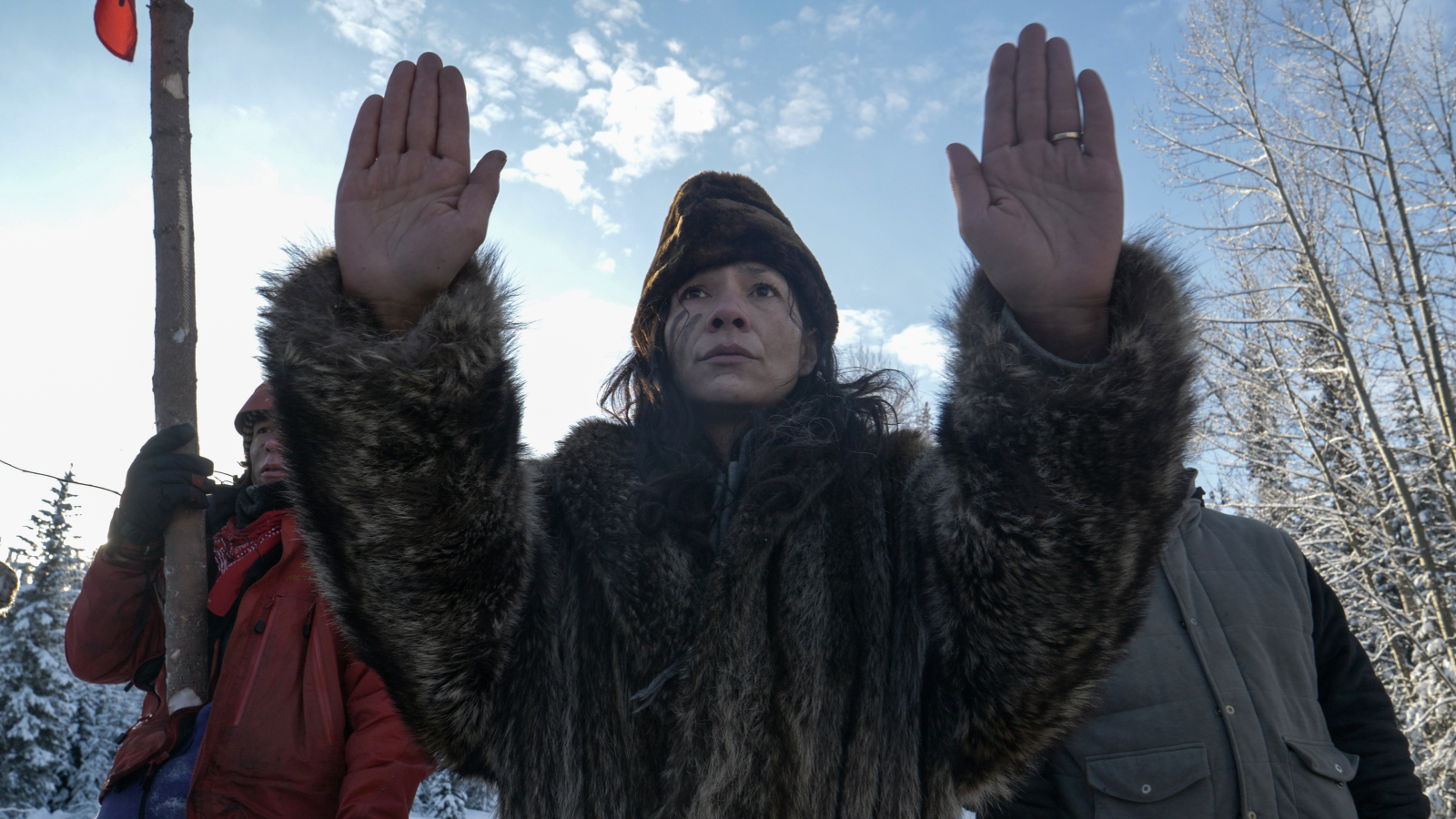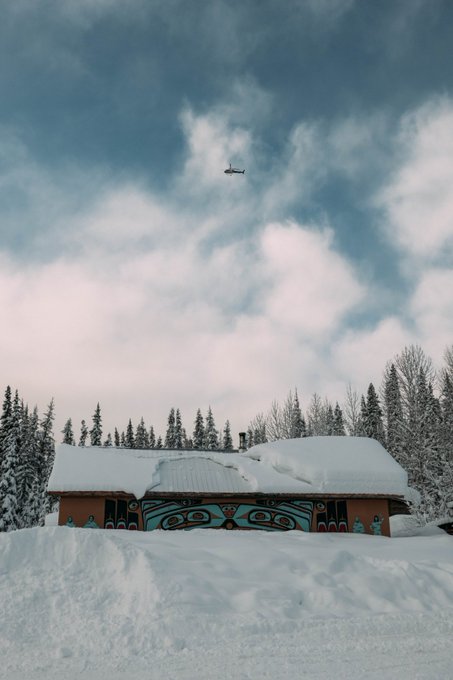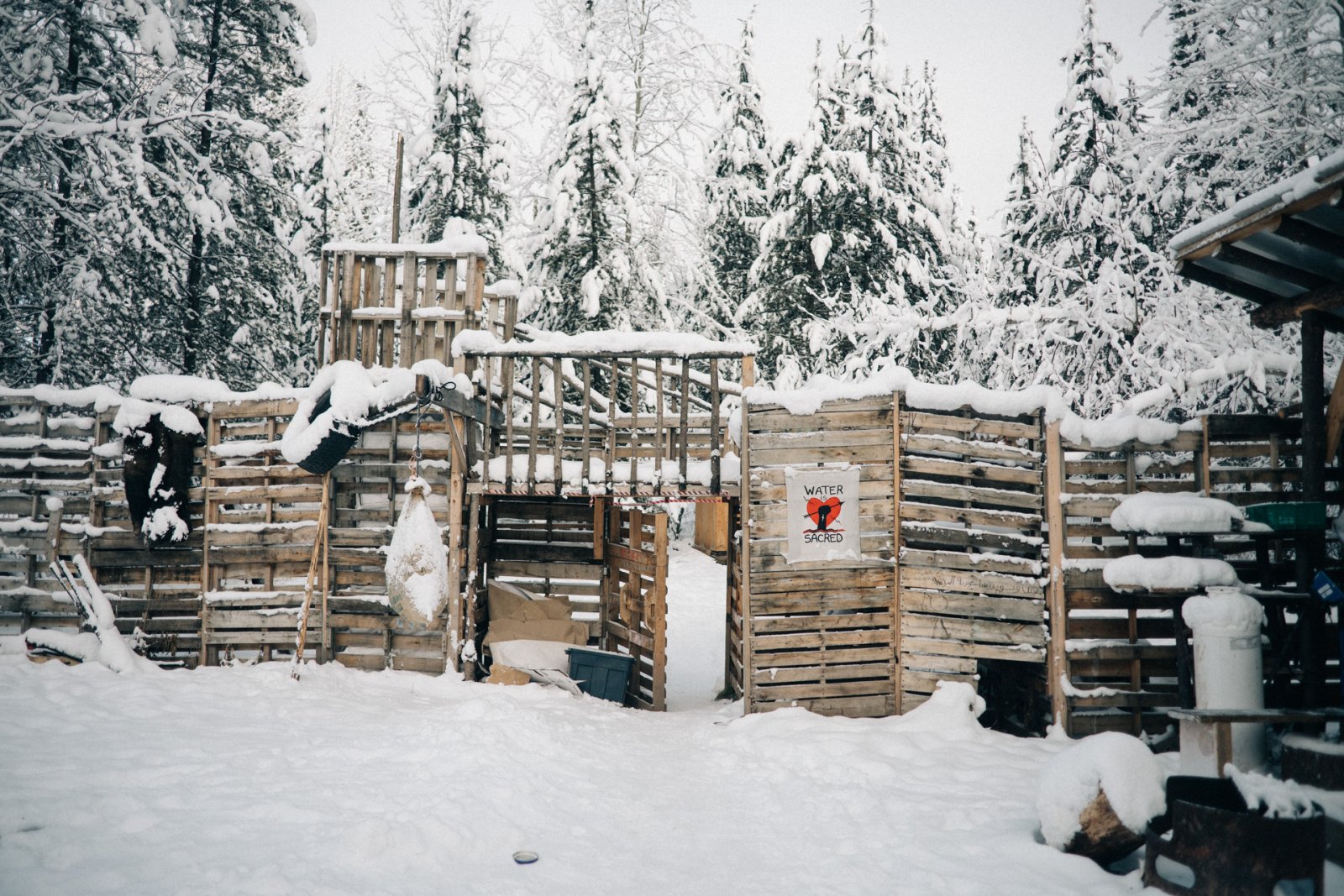
Sabina Dennis holds her hands up as RCMP tactical teams approach the Gidimt’en checkpoint on Wet’suwet’en territory on Jan. 7, 2019. Photo by Michael Toledano
Surveillance helicopters circling overhead. Police officers, some carrying tactical gear, pouring into the surrounding towns. An elder arrested, then released, for trying to go past a police checkpoint.
On the ground along a remote forest road in northern B.C., members of the Wet’suwet’en Nation say police presence has been ramping up, despite assurances from the RCMP that officers would stand down as Wet’suwet’en hereditary chiefs and officials from the British Columbia government met to try to de-escalate the ongoing dispute over the Coastal GasLink pipeline.
On Tuesday night, the hereditary chiefs announced that the talks had broken down, leaving the looming possibility that the RCMP will “imminently” move into the nation’s territory. Tensions in the region have been high since January 2019, when the RCMP violently arrested 14 people while enforcing a court order to remove the Wet’suwet’en from the path of the pipeline’s construction.
“Efforts to de-escalate the situation on the territories were severed when the province refused to pull the permits they issued to (Coastal GasLink),” said Smogelgem, a Wet’suwet’en hereditary chief of the Fireweed Clan, on Twitter.
Coastal GasLink, a natural gas pipeline, would run through unceded Wet’suwet’en territory over the objections of the nation’s hereditary chiefs. Members of the nation have set up several camps along the Morice West Forest Service Road, about 1,200 kilometres north of Vancouver, to reoccupy their traditional lands and block resource projects.
Before the chiefs announced discussions with the province, the RCMP had been preparing to enforce a second injunction the B.C. Supreme Court granted to Coastal GasLink on Dec. 31. After seven days of talks known as Wiggus — the Wet’suwet’en word for respect — were announced, RCMP confirmed more officers were still being deployed in the area.
In a press release late Tuesday, the hereditary chiefs said a mediator had been in touch with the pipeline company after two days of talks.
“Coastal GasLink declined to see this discussion resulting in progress,” the statement said. “Therefore, the enforcement of the injunction zone is imminent.
The chiefs also urged peace, saying they remain committed to the Wiggus process and “will continue discussions with the Province of British Columbia.” A representative didn’t immediately return a call from National Observer.
In a press release, B.C. Minister of Indigenous Relations and Reconciliation Scott Fraser, emphasized the need for safety.
Talks between the Wet’suwet’en the B.C. government ended without resolution late on the evening of Feb. 4. The community fears violence may be imminent as RCMP stage in nearby towns. #bcpoli
“It was very clear from our discussions that all of us came together in good faith to try to find a way forward together,” the statement said. “While we were not successful in finding a resolution to the current situation, we continue to remain open to dialogue with the Wet’suwet’en leadership on this issue.”
TC Energy, which owns Coastal GasLink, said in a statement that its senior leadership had been in nearby Smithers, B.C. to meet with the hereditary chiefs “if required,” but “unfortunately, we were unable to meet with the chiefs.” The company said it must quikcly resume construction to meet its various business commitments.
“In the coming days, Coastal GasLink will resume construction activities,” the statement read. “It is our hope that the resumption of construction activities occurs in a lawful and peaceful manner that maintains the safety of all in the Morice River area.”
The community now fears more violence may be imminent — especially as at least three of the same commanding officers who spearheaded last year’s RCMP efforts appear to be again leading the charge.
“They’re exactly the same oppressive violent force of oppression that they were on Jan. 7 last year,” said Molly Wickham, also known as Sleydo, a spokesperson for the Gidimt’en Clan of the Wet’suwet’en Nation.
“They haven’t learned a thing.”
Wickham was one of those arrested last year. In an interview Tuesday, she said three of the same commanding officers from 2019 — John Brewer, Robert Pikola and Dave Attfield — are still around now.
“People recognize them,” she said, adding that the hereditary chiefs have unsuccessfully asked for those commanders to be reassigned. “They know who they are, because (the officers) were responsible for what happened last year.”
The RCMP confirmed that Brewer is still deployed in the area, but “we respectfully decline in identifying any other officers from incidents that took place last year,” RCMP spokesperson Staff. Sgt. Janelle Shoihet said in an email Tuesday.
According to a report in the Guardian, the officers leading the 2019 effort were prepared at the time to use deadly force against the Wet’suwet’en.

‘Lethal overwatch’
Citing detailed notes from an RCMP strategy session held before the RCMP swept the Wet’suwet’en checkpoint, the British newspaper reported that snipers were present, and officers had been prepared to use “lethal overwatch” — a police term that is understood to mean an officer is prepared to use lethal force. They were also instructed to use “as much violence… as you want” in “sterilizing (the) site,” the Guardian said.
The notes were stamped with Pikola’s name, the Guardian said.
The RCMP has strongly denied the Guardian’s reporting, saying lethal overwatch “does not indicate action other than observation.” That statement contrasts with a 2010 memo produced by the B.C. RCMP., and a review of military and law enforcement literature in both Canada and the US conducted by the Guardian.
The RCMP has also said snipers were sent as part of larger emergency response teams that are generally deployed all at once, according to a statement released after the article was published. Initially, the RCMP had said it wasn’t able to locate or verify the documents referenced by the Guardian; the organization has since found them, said Shoihet.
“We would also add that information was taken out of context and (there was) significant work done with respect to discussions, meetings, protocols, cultural training, etc.,” said Shoihet in an email.
“We have no intention in contributing to the tensions, but will ensure that allegations or misinformation is corrected when it comes to our actions. As we have stated repeatedly, we have not and will not take action to enforce the B.C. Supreme Court-ordered injunction by removing the obstructions on the Morice West Forest Service Road during this time.”
Brewer in particular is a “veteran, decorated police officer who himself is Indigenous,” though not Wet’suwet’en, Shoihet added. “We have well-trained and experienced personnel, including our operational commanders, overseeing our efforts prior to last year’s enforcement and since.”
Wickham said learning about Wet’suwet’en culture and employing Indigenous officers still doesn’t give the RCMP the right to remove community members from their home.
“Seeing a brown face or another Indigenous person harassing us and oppressing us in those same ways for the benefit of profit and ongoing colonization is quite frustrating, and by no means does it de-escalate the situation,” Wickham said.
“It’s a sad, sad thing… it’s so offensive that they’d even bring it up.”

‘We are under duress’
The case of the Wet’suwet’en and Coastal GasLink exposes a stark divide between the traditional Wet’suwet’en legal system and Canada’s colonial legal system. Under Wet’suwet’en law, authority over the nation’s 22,000 square kilometres of unceded territory lies with hereditary chiefs from five clans, who oppose the pipeline. But TC Energy, which owns the pipeline project, received approval to build the pipeline from some elected band councils, a governing body created by Canada’s colonial Indian Act, which have jurisdiction over reserve lands but not the disputed territory.
A 1997 Supreme Court of Canada decision affirmed that the provincial government can’t extinguish the hereditary chiefs’ right to their land. However, the court also sent the case back for a second trial that hasn’t yet happened, leaving key questions unresolved.
Stating concerns about safety after the raid last January, the hereditary chiefs struck a temporary deal to allow Coastal GasLink to access the territory for pre-construction work.
But tensions smoldered in the months that followed, and were re-ignited with the Dec. 20 publication of the Guardian article, and the court injunction granted on Dec. 31
Also citing public safety concerns, the RCMP set up a blockade along the forest road on Jan. 13 and have restricted access to the area, prompting complaints from the B.C. Civil Liberties Association. In the weeks since, the Wet’suwet’en community says it has felt under siege.
The RCMP initially denied that it was surveilling Wet’suwet’en camps by air — until photo evidence surfaced, as reported by Vice. Over the course of several days, community members posted reports on social media of large numbers of police staging in towns near the service road.
RCMP helicopter again circling @UnistotenCamp and Gidimt’en Checkpoint this morning. Photographed here over the Wedzin Kwa river and the #Unistoten bunkhouse.#wetsuwetenstrong
Then, on Friday night, a Gidimt’en Clan elder was arrested and released without being charged after she tried to pass the police blockade without giving RCMP her ID. Carmen Nikal, 73, has been an adopted member of the Gidim’ten Clan’s Cas Yex house for four decades, Gidimt’en Clan said.
“Good faith discussions between the Wet’suwet’en and the Province cannot occur while we are under duress, and while our families and guests face the threat of police violence,” the clan said in a press release.
In a tweet Tuesday, Smogelgem said “it feels like reconciliation is being brutally killed here in Wet’suwet’en territory.”
RCMP harassment and build up continues while I sit in talks with the Province. There are a lot of sceptics in the room. There are good reasons for that. The #Wetsuweten have survived the “Rules of Law” since contact and have become #WetsuwetenStrong
“But out on the territory, people are strong and gaining strength every single day from being on the land,” she said.
“I don’t think there’s a lot of fear. There’s a lot of strength.” SOURCE










